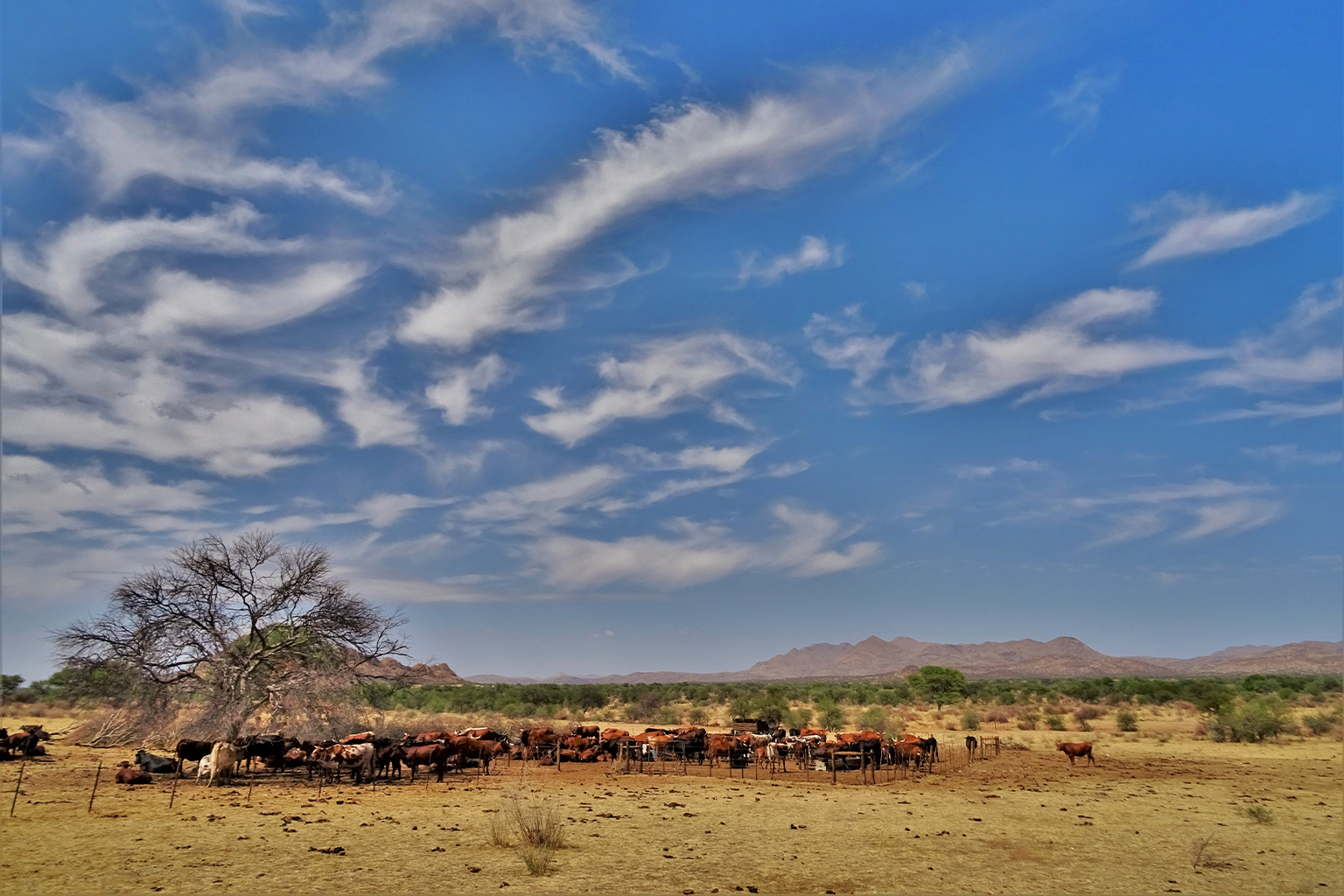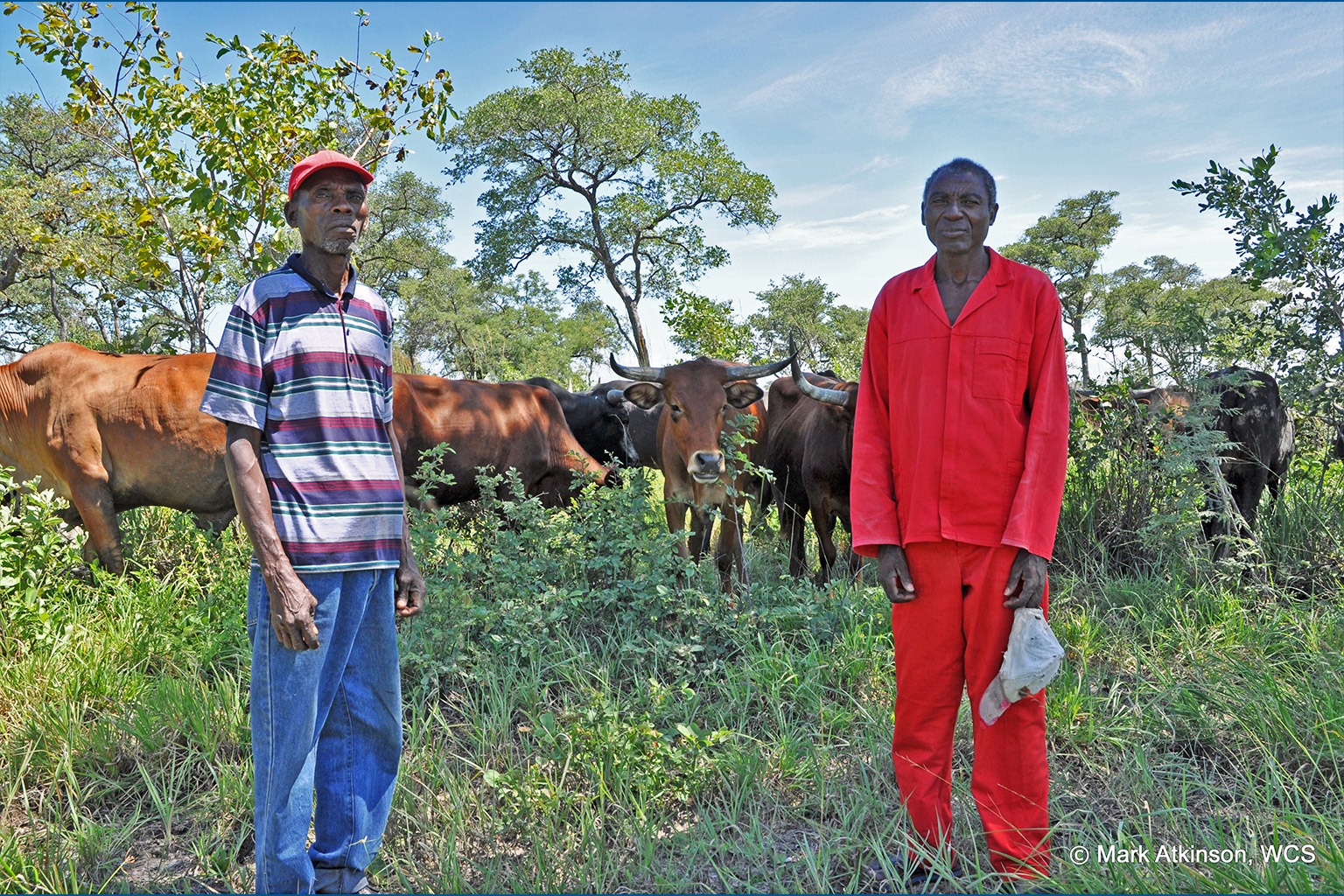Land degradation, changing vegetation patterns, and depleting soil quality threaten rangeland across Africa, including Namibia.The Community-Based Rangeland and Livestock Management (CBRLM) program, funded by the U.S. and implemented by a German consultancy, supported herders in northern Namibia to manage communal rangeland.However, the intervention didn’t improve livestock health or herders’ incomes, while rangeland quality actually worsened.While community management failed to deliver the desired results, evaluators say program design flaws were also to blame, in particular issues of land tenure and barriers to creating a livestock market.
Rangelands cover more than 40% of the African continent and about half of Namibia. Large portions of Namibia’s rangelands are communal, serving as shared pastures for livestock and wildlife. These open, uninterrupted lands are threatened by degradation, changing vegetation, and diminishing soil quality.
The Northern Communal Areas (NCAs) make up a fifth of Namibia’s landmass but are home to about half of the country’s population and cattle, in part a legacy of colonial relocation. The 1.2 million people living here are predominantly pastoralists and agropastoralists, herding livestock using traditional methods.
Between 1970 and 2020, Namibia’s population tripled in size. This and the reduced mobility of herds are adding to the stress on these unfenced lands, according to anthropologist Michael Bollig. Apart from direct human pressures, climatic disruptions are also leading to greater aridity and promoting woody encroachment.
In the south of the country, individuals own stretches of rangeland as private property, with each landowner making their own decisions about herd size and grazing, and managing their land with more or less success. But in the NCAs, communities displaced from richer, more hospitable land in the south to make way for settlers have had to adapt their traditional herding practices and economies to a new landscape.
Cattle from the Northern Communal Areas (NCAs). In the NCAs, communities displaced from richer, more hospitable land in the south to make way for settlers have had to adapt their traditional herding practices and economies to a new landscape. Image by Alex Derr via Flickr (CC BY-NC-SA 2.0).
Between 2010 and 2014, the Millennium Challenge Corporation, a U.S. foreign aid agency, funded a program to encourage communities to set up formal management structures for communal rangeland. The Community-Based Rangeland and Livestock Management (CBRLM) program was implemented by GOPA, a German consulting firm that provides organizational, planning and training assistance.
Under this program, community members developed grazing plans. Instead of several herds grazing independently, owners came together to coordinate grazing. The aim was to merge smaller herds into a single larger one feeding on one stretch of rangeland at a time, letting the remaining pasture rest, a method called rotational grazing. Cattle owners were also given training on livestock management, including structuring herds to improve productivity, and provided access to vaccination and veterinary care. The third component was designing cattle marketing plans.
The MCC commissioned an evaluation of the program following its closure in 2014. A team of researchers from the U.S. and the U.K., led by scientists from Utah State University, analyzed grass samples and satellite imagery and found that degradation persisted in areas covered by the CBRLM program.
“People were very eager to improve community-based institutions,” said Dylan Groves, co-author of a study based on the analysis in the journal Nature Communications. But “it didn’t have the effects that were hoped for in terms of environmental and economic outcomes.”
In fact, rangeland health worsened slightly, said Groves, a political scientist at Columbia University. The researchers found livestock health didn’t improve, nor did the incomes of participating households, some of the country’s most disadvantaged.
Namibia, a sparsely populated nation of 2.6 million in Southern Africa, is designated an upper-middle-income country by the World Bank, but is plagued by staggering inequality. The deprivation doesn’t flow from natural causes.
The country’s German colonizers systematically stripped Black Namibians of their land, ignoring traditional communal rights to land, and corralled them onto reserves across the country. Areas in the more arid north, where most of the native Black population were sent, were isolated and marginalized. After Namibia gained independence in 1990, one of its main challenges was undoing the effects of decades of colonial misrule.
 The country’s German colonizers systematically stripped Black Namibians of their communal lands and sent them to the more arid north. Image by Konstantin via Flickr (CC BY-NC-ND 2.0).
The country’s German colonizers systematically stripped Black Namibians of their communal lands and sent them to the more arid north. Image by Konstantin via Flickr (CC BY-NC-ND 2.0).
In the early 1960s, Namibia’s new colonizers, the apartheid South African government, attempted to quell mounting discontent in the NCAs by drilling boreholes. This divorced grazing patterns and herd sizes from the constraints of water availability. Instead of moving in search of water, herds became tethered to borehole locations.
Despite this, borehole construction was one of the ways GOPA attempted to alleviate the water shortages in target areas. This is one of the reasons why the project’s poor performance can’t be considered a definitive vote against communities’ stewardship of rangelands. Part of the failure, the evaluation found, could be traced to flaws in the program design.
For the CBRLM program, GOPA mapped out 38 rangeland intervention areas (RIAs), demarcated by locally recognized boundaries. The agency implemented the program in 19 RIAs, while the others served as a control group.
One of the big pitfalls of the project was that it didn’t address underlying land tenure issues. There was nothing to prevent herd owners who weren’t part of the program from using an RIA painstakingly conserved by a management committee. Boreholes constructed on communal lands under the project made these areas more attractive to outsiders seeking a scarce resource: water.
Mutjinde Katjiua, a professor of land and property sciences at the Namibia University of Science and Technology, told Mongabay the project’s five-year duration was too short to deliver meaningful results. Dry conditions that erode land and animal health can persist for several years. The main interventions under the CBRLM took place over just two years.
The program designers anticipated that greener pastures and healthier livestock would induce herders to participate in livestock markets. Animal sales could potentially reduce pressure on the grasslands. Yet GOPA’s attempts to facilitate exports to neighboring Zimbabwe and Angola were unsuccessful. Small herders didn’t appear keen to turn their cattle into cash.
 Two herders with their cattle. Image by Mark Atkinson/WCS via Flickr (CC BY-NC 2.0).
Two herders with their cattle. Image by Mark Atkinson/WCS via Flickr (CC BY-NC 2.0).
As in many parts of the world, cattle are more than commodities here, Katjiua said. Owning livestock bestows prestige; bulls are slaughtered to mark important occasions like weddings and funerals. Cattle are a form of wealth and currency that market-derived monetary gains can’t always match.
Besides, the average herd size in the NCAs isn’t large enough for market trading to be attractive. All the households included in the project owned at least 10 animals, which is small for a cattle herd. “Marketing is impossible with small herds. It is not an issue of animal health. It is about the numbers,” Katjiua said.
There was another major impediment to creating a cattle market profitable for herding communities in the north: Namibia’s notorious veterinary cordon fence (VCF). The Germans installed this “red line” to prevent the spread of livestock disease, particularly the highly contagious foot-and-mouth disease (FMD), from the northern to the white-dominated southern areas. The regions where the CBRLM program operated lie north of the VCF. Livestock movement across the VCF is still heavily regulated because FMD hasn’t been stamped out. The latest outbreak occurred in 2022 in the northeast of the country.
Meat from the grass-fed, antibiotic-free cattle living off rangeland in the NCAs would otherwise be prized in the international market. Namibia’s second-most important export to the EU is beef. But it comes from cattle farms south of the VCF. The Namibian government wants to create a more inclusive national livestock market. Still, its efforts to enable herders in the north from partaking in this lucrative trade have so far failed.
“The real focus should have been on land rights,” Katjiua told Mongabay. “Other herders were coming in to poach the grass. Those who were doing the management did not have the right to exclude others.”
This isn’t a particularly novel revelation. More than 20 years ago, the Northern Regions Livestock Development Project (NOLIDEP), financed by a loan from the U.N.’s International Fund for Agricultural Development and a bevy of international donors, ran into similar challenges.
“Responsible community-based natural resource management requires security of tenure,” Roy H. Behnke, a British-American researcher who conducted a series of studies on the program, noted in 1998. Behnke described the NOLIDEP project as a “large-scale, open-air experiment in participatory resource management.”
Banner image: Sanga cattle on Zambezi River bank. Image by Andrew Ashton via Flickr (CC BY-NC-ND 2.0).
Namibia’s first peoples struggle to access their traditional lands (commentary)
Citations:
Coppock, D. L., Crowley, L., Durham, S. L., Groves, D., Jamison, J. C., Karlan, D., … Ramsey, R. D. (2022). Community-based rangeland management in Namibia improves resource governance but not environmental and economic outcomes. Communications Earth & Environment, 3(32). doi:10.1038/s43247-022-00361-5
Behnke, R. H. (1998). Grazing systems in the northern communal areas of Namibia: A summary of NOLIDEP socio-economic research on range management.
Nghitevelekwa, R. V. (2016). Land relations and property rights in central-north Namibia’s communal areas. In M. Ramutsindela, G. Miescher, & M. Boehi (Eds.), The Politics of Nature and Science in Southern Africa (pp. 208-230). doi:10.2307/j.ctvh9vtrj.12
Robinson, L. W., Eba, B., Flintan, F., Frija, A., Nganga, I. N., Ontiri, E. M., … Moiko, S. S. (2021). The challenges of community-based natural resource management in pastoral rangelands. Society & Natural Resources, 34(9), 1213-1231. doi:10.1080/08941920.2021.1946629
Bollig, M. (2020). Shaping the African Savannah: From capitalist frontier to arid Eden in Namibia. Cambridge University Press.
FEEDBACK: Use this form to send a message to the author of this post. If you want to post a public comment, you can do that at the bottom of the page.
Agriculture, Cattle, Cattle Pasture, Cattle Ranching, Community Development, Degraded Lands, Environment, environmental justice, Indigenous Peoples, Indigenous Rights, Land Rights, Livestock
Africa, Namibia, Southern Africa, Sub-Saharan Africa
Source link : https://news.mongabay.com/2023/07/even-community-stewardship-cant-save-rangeland-beset-by-legacy-of-misrule/
Author :
Publish date : 2023-07-21 07:00:00
Copyright for syndicated content belongs to the linked Source.





